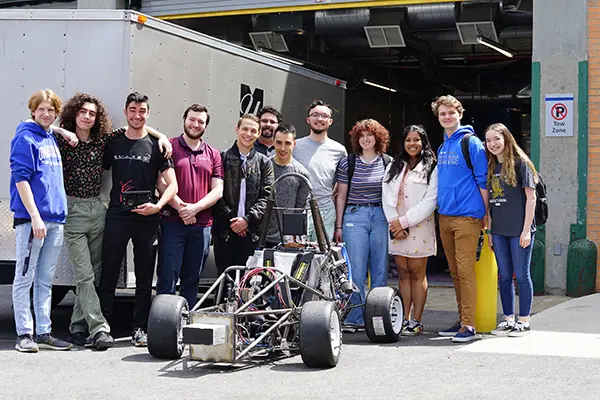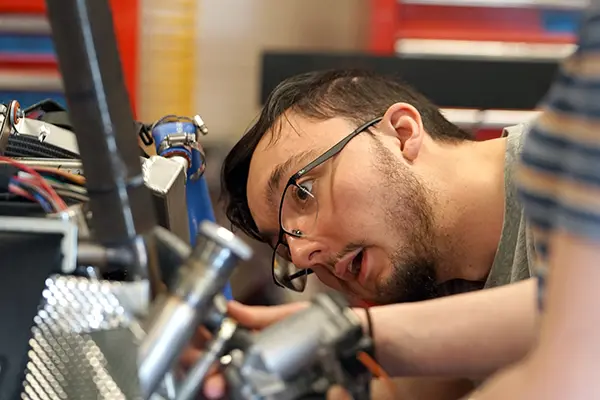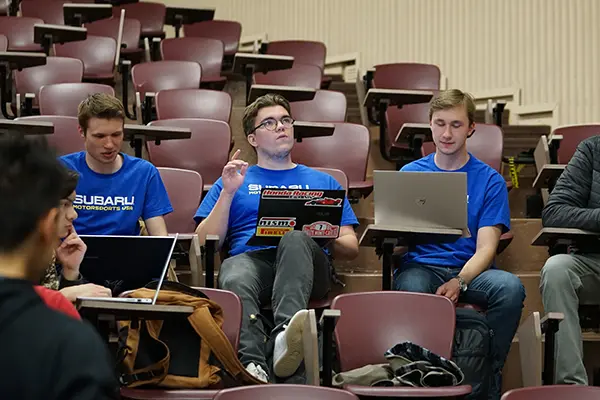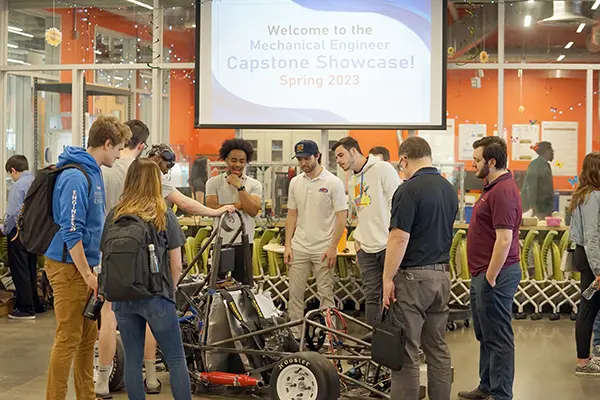After Rebuilding Club and Car, Students Head to Formula SAE Race in Michigan
 Image by Ed Brennen
Image by Ed Brennen
05/12/2023
By Ed Brennen
Behind the driver’s seat of the River Hawk Racing team’s Formula One-style race car are two Red Bull energy drink cans, one attached to each side of the frame. They’re not part of a corporate sponsorship deal, nor are they there should the driver need a midrace pick-me-up. Rather, the empty cans are actually cost-effective engine components.
“They’re called catch cans. If the coolant overflows, it can go into the can,” explains junior mechanical engineering major Aaron Bouchard, president of River Hawk Racing, the student club that is UMass Lowell’s chapter of SAE International (formerly the Society of Automotive Engineers).
When you’re building a race car from scratch on a strict budget to compete against 119 other schools from across North America in a Formula SAE competition, a little resourcefulness goes a long way.
 Image by Ed Brennen
Image by Ed Brennen
“It’s a valuable experience that you can put on your résumé, and it proves that you’re taking what you learned in the classroom and applying it to a project outside the classroom,” says senior mechanical engineering major Garrett Perry, the team’s chief engineer.
As club president his sophomore and junior years, Perry helped hold River Hawk Racing together during the remote virtual days of the pandemic. Membership has rebounded to about 50 students this year, and at the Student Leadership Awards in April, the club won the “Rising River Hawks Award,” which recognizes a student organization that has demonstrated the greatest amount of growth and promise.
“It was important to us to get that recognition from the university,” says junior plastics engineering major Ryan Tangney, club vice president and powertrain lead for the project. “In addition to proving to ourselves that we could do it, we had to prove to the university that we are still worthy of putting their name on the car.”
 Image by Ed Brennen
Image by Ed Brennen
While River Hawk Racing is geared toward mechanical engineering students (Asst. Teaching Prof. Jonathan Perez de Alderete is the advisor), the team welcomes all students.
Psychology major Arshjot Kaur discovered the team as a first-year student at the Engagement Fair and served as club secretary this year. Growing up in Westford, Massachusetts, Kaur watched NASCAR races on TV with her dad. She was happy to find a way to pursue her love of cars in college.
“I’ve created a lot of friendships, and I try to make it welcoming for other students,” says Kaur, whose duties include communicating with sponsors and keeping team members up to date through emails and announcements.
As a non-engineer, she says she has learned a lot by spending time at the garage on North Campus where the car is being built.
 Image by Ed Brennen
Image by Ed Brennen
River Hawk Racing’s business team, led by junior marketing student Joe Dunn, is responsible for finances and sponsorship opportunities. The team has raised over $40,000 this year, with funding coming from sponsors such as the Gene Haas Foundation, Parker Hannifin, Autodesk, SolidWorks and CADSPARC. The team also receives support from the university, solicits crowdfunding and hosts car shows on campus that raise more than $1,000 each semester.
“A lot of effort goes into finding and connecting with sponsors,” says Dunn, who describes himself as a “big Formula One fan” who grew up in a “family of mechanics” in Littleton, Massachusetts. He sees his work with River Hawk Racing as a test drive for his ultimate goal of working in sales and marketing for a motorsports team.
“It’s a good opportunity to interact with people outside my major,” Dunn says. “It’s really like working at a company, where you communicate and collaborate with people in different fields and with different skill sets. The experience will be useful to me when I have a job out in the real world.”
 Image by Ed Brennen
Image by Ed Brennen
“We figured that was the fairest way to do it,” Tangney says.
Besides socket wrenches and motor oil, team members are bringing their résumés to the competition in Michigan, where companies such as Tesla, Rivian, GM, Ford and SpaceX actively recruit future employees.
“A lot of what you learn in class is applied to what we do with the car,” Bouchard says while working with team members on the vehicle in the North Campus garage. “You take a computer-aided design course, then you come here and use that software to design parts of the car. Then you’re actually making them and putting them on the car correctly.”
Tangney, the only plastics engineer on the team, used a 3D printer to create the car’s plastic air intake. The Attleboro, Massachusetts, native says River Hawk Racing has been “such a good motivator” for him academically.
“Everyone says, ‘When am I going to use Calc 3?’ or ‘What’s an integral for?’ And when we’re designing, you have to use those things,” he says. “It’s really pivotal for me as a college student. I’m taking thermodynamics, which helps me with the design of the exhaust. Being able to apply that is really cool.”
